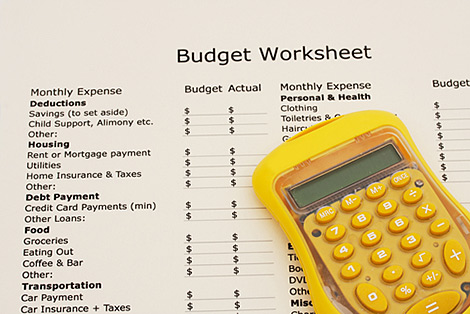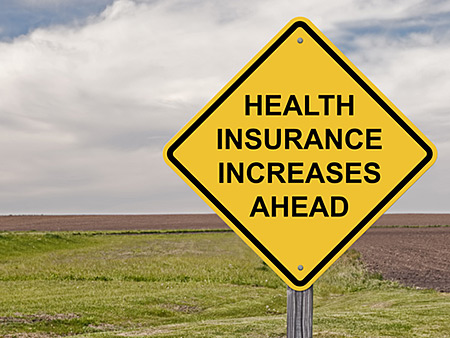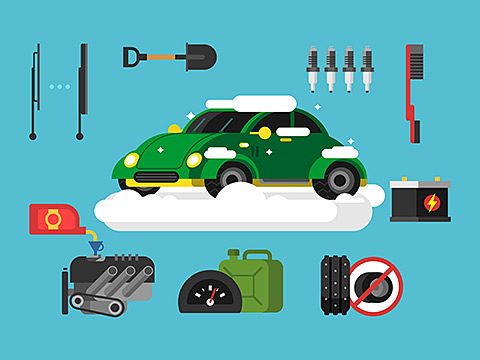|
In this issue:
Steps to Creating a Household Budget
Study Projects Health Insurance Premiums to Rise in 2017
Getting Your Vehicle Ready For Winter
| Steps to Creating a Household Budget |
| |
 Making a budget is a key piece of a strong financial foundation. Having a budget helps you manage your money, control your spending, save more money, pay off your debt, or stay out of debt. Without an accurate picture of what's coming into and going out of your account, you can easily rely on credit cards and loans to eat and pay your bills. If you already have one, now's a good time to update it. Making a budget is a key piece of a strong financial foundation. Having a budget helps you manage your money, control your spending, save more money, pay off your debt, or stay out of debt. Without an accurate picture of what's coming into and going out of your account, you can easily rely on credit cards and loans to eat and pay your bills. If you already have one, now's a good time to update it.
Download and print a Budget Worksheet. Using a worksheet will help you get started. You can use it to complete all the steps below. You can also create your own budget worksheet using spreadsheet software or even paper and pen.
List your income. Add up all reliable sources of income - wages from a job, alimony, child support, etc. Notice I say reliable. If you sometimes get cash from outside jobs or hobbies, but it's not on a regular basis, don't put this down as income on your budget. Your budget should be a document you can depend on.
If you're self-employed or have a fluctuating income, use an average monthly income or an estimate of the income you expect to receive that month.
Add up your expenses. Some of your monthly expenses are fixed - mortgage/rent, property taxes, child support, alimony - while others may vary - electricity, water, groceries. List all the fixed expenses and the amount of the expense.
For your variable expenses, write the maximum amount you plan to spend in that category or the amount you expect your bill to be. For example, you might plan to spend $200 on groceries and $150 on gas.
Use your monthly statements to help you figure out what you typically spend each month and to make sure you're not leaving out spending in any categories.
Some of your expenses don't occur each month. But, accounting for those periodic expenses in your monthly budget can make it easier to afford them when they're due. Divide yearly expenses by 12 and semi-annual expenses by 6 to come up with the monthly amount to spend in those categories.
Calculate your net income. Your net income is what you have left over after all the bills are paid. You want this to be a positive number so you can put it toward your debt. Calculate your net income by subtracting your expenses from your monthly income. Write down the number, even if it's negative.
Adjust your expenses. If your net income is negative, it means you've budgeted to spend more than your income. You'll have to correct this, otherwise you'll run into trouble during the month. Variable expenses are typically the first places you can adjust spending, e.g. groceries, eating out, hobbies, gas. Even some of your fixed expenses can be adjusted, e.g. reduce your cable or phone bill, cancel the gym membership, don't take a vacation this year.
Evaluate your spending using a "wants vs. needs" analysis. Reduce or eliminate spending in those "want" areas to make more room for the things you "need" to spend money on.
Track your spending. Throughout the month, track your actual spending against what you budgeted. If you go over budget, this will help you figure out where you spent more money. In the future, you can take greater care not to overspend in that area. Or, you may need to adjust your budget to compensate for the additional spending. If you increase your budget in an area, decrease it in another area to keep from going over your budget.You can find sale prices on laptops throughout the summer; however, we saw the greatest number of Editors' Choice deals in August last year. But although September had 4 percent fewer deals than the previous month, you can anticipate many retailers to make deeper price cuts for Labor Day weekend. For example, Dell Outlet bumped up its discount from 35 percent the month before to 45 percent off for the holiday.
Article courtesy of TheBalance.com
Back To Top
|
| Study Projects Health Insurance Premiums to Rise in 2017 |
| |
 Next year's premiums for health coverage under the Affordable Care Act could rise more than in past years in most markets and declines might be rare, according to a preliminary analysis of insurers' plans. Next year's premiums for health coverage under the Affordable Care Act could rise more than in past years in most markets and declines might be rare, according to a preliminary analysis of insurers' plans.
Overall, premiums for a popular type of plan - the second-lowest silver plan - could rise 10 percent on average next year in 14 major metropolitan areas, according to an analysis released Wednesday by the Kaiser Family Foundation. Kaiser based its projections on insurers' preliminary rates filed with state regulators, which remain subject to state or federal review. (KHN is an editorially independent program of the foundation.)
Last year, premiums for the second-lowest silver plan in those metro areas rose 5 percent after state insurance departments signed off, Kaiser said. In Kaiser's study, premiums for the lowest-cost silver plan are projected to rise in all but two of the 14 markets checked. In Portland, Oregon, premiums for the lowest-cost health insurance plans under the Affordable Care Act may increase next year by an average of 26 percent.
But in Providence, Rhode Island, consumers might see rates drop by 14 percent.
The report's authors also suggested comparison shopping could help consumers beat rate hikes, but they might have to switch insurers - and potentially their doctors - to avoid a big increase. Open enrollment begins Nov. 1.
As insurers' plans firm in coming months, the future of Obamacare premiums could be a topic of intensifying debate between the two major presidential candidates and those in other contested political races.
Nearly 13 million Americans bought coverage on the marketplaces this year. In contrast, more than 150 million Americans get coverage through their employer, and in excess of 100 million are covered by Medicare or Medicaid.
More than eight in 10 marketplace enrollees won't be directly affected by increases in premiums because they receive a government subsidy that will insulate them.
It's still too early to tell whether Kaiser's projections will reflect the national trend because data is only available for a quarter of all states and none yet for big ones such as Florida, California and Texas. California was due to release information on 2017 premiums in July, but Texas, Florida and other states won't release any until the marketplace opens in November.
Still, the premium data that Kaiser obtained from 13 states and Washington, D.C., could offer a clue to what people will face this fall.
"We have tracked these same states as an early indicator of premium changes for the past few years and, while on average they have never been far off from the national average, we don't know yet whether they are necessarily representative for 2017," said Cynthia Cox, a co-author of the Kaiser report.
The Kaiser analysis examined the two lowest-cost silver plans because more than two-thirds of marketplace enrollees choose them. The second lowest-cost plan also is the benchmark used to calculate government premium subsidies.
Article courtesy of Kaiser Health News/PBS
Back To Top
|
| Getting Your Vehicle Ready For Winter |
| |
 It's foolhardy to head out in a poorly maintained vehicle in the dead of winter, of course, but even vehicle owners in temperate zones need a car care check as the days grow shorter, note the pros with the nonprofit National Institute for Automotive Service Excellence (ASE), an independent group that tests and certifies the competence of auto technicians. It's foolhardy to head out in a poorly maintained vehicle in the dead of winter, of course, but even vehicle owners in temperate zones need a car care check as the days grow shorter, note the pros with the nonprofit National Institute for Automotive Service Excellence (ASE), an independent group that tests and certifies the competence of auto technicians.
"Regular, routine maintenance can help improve your gasoline mileage, reduce pollution, and catch minor problems before they become big headaches," says Tony Molla, vice president of communications at ASE. ASE offers these car care tips to give you peace of mind during fall and winter driving:
- Before you do anything else, read your owner's manual and follow the manufacturer's recommended service schedules.
- Get engine performance and driveability problems - hard starts, rough idling, stalling, diminished power, etc. - corrected at a reputable repair shop that employs ASE-certified repair professionals. Cold weather makes existing problems worse.
- Replace dirty filters, such as air, fuel, and PCV. A poorly running engine is less efficient and burns more gasoline.
- As the temperature drops below freezing, add a bottle of fuel deicer in your tank once a month to help keep moisture from freezing in the fuel line. Keeping the gas tank filled also helps prevent moisture from forming.
- Change your oil and oil filter as specified in your manual - more often if your driving is mostly stop-and-go or consists of frequent short trips. A poll of ASE Master Auto Technicians revealed that regular oil and filter changes is one of the most frequently neglected services, yet one that is essential to protect your engine.
- The cooling system should be flushed and refilled as recommended. The level, condition, and concentration of the coolant should be checked periodically. A 50/50 mix of antifreeze and water is usually recommended. Do-It-Yourselfers: Never remove the radiator cap until the engine has thoroughly cooled! The tightness and condition of drive belts, clamps, and hoses also should be checked regularly by a professional technician.
- The heater and defroster must be in good working condition for passenger comfort and driver visibility.
- Replace old blades regularly. If your climate is harsh, purchase rubber-clad (winter) blades to fight ice build-up. Stock up on windshield washer solvent - you'll be surprised how much you use during the winter months. And don't forget to always carry an ice scraper.
- Have your battery checked. The only accurate way to detect a weak battery is with professional equipment. However, most motorists can perform routine care: Wear eye protection and protective rubber gloves. Scrape away corrosion from posts and cable connections; clean all surfaces; retighten all connections. If battery caps are removable, check fluid level monthly. A word of caution: Removal of cables can cause damage or loss of data/codes on some newer vehicles, so always check your owner's manual first. Be sure to avoid contact with corrosive deposits and battery acid.
- Inspect all lights and bulbs. Replace burned-out bulbs; periodically clean road grime from all lenses. To prevent scratching, never use a dry rag. Clouded lenses can be refinished by many service outlets or by using a DIY kit found in major auto parts outlets.
- Exhaust fumes inside your vehicle's cabin can be deadly. Have the exhaust system examined for leaks and problems while the vehicle is on a lift. The trunk and floorboards should also be inspected for small holes.
- Worn tires are dangerous in winter weather. Examine tires for remaining tread life, uneven wearing, and cupping; check the sidewalls for cuts and nicks. Check tire pressure once a month, letting the tires "cool down" before checking the pressure. Rotate as recommended. Don't forget to check your spare, and be sure the jack is in good working condition. Under-inflated tires or poorly aligned wheels makes your engine work harder and thus use excess gasoline.
- Have your brakes checked periodically for safety and to prevent costly repairs that can be caused by neglect.
- The transmission is often neglected until a major failure. Routine checks and fluid changes at prescribed intervals can prevent very costly repairs down the line.
- Always carry an emergency kit with you: extra gloves, boots and blankets; flares; a small shovel and sand or kitty litter; tire chains; a flashlight and extra batteries; and a cell phone and extra car charger. Put a few "high-energy" snacks in your glove box.
The National Institute for Automotive Service Excellence (ASE) was founded in 1972 as a nonprofit, independent organization dedicated to improving the quality of automotive service and repair through the voluntary testing and certification of automotive technicians. ASE-certified technicians wear blue and white ASE shoulder insignia and carry credentials listing their exact area(s) of certification. Their employers often display the blue and white ASE sign.
For more information, including seasonal car care tips, visit www.ase.com.
Article courtesy of ase.com
Back To Top |
|

 Making a budget is a key piece of a strong financial foundation. Having a budget helps you manage your money, control your spending, save more money,
Making a budget is a key piece of a strong financial foundation. Having a budget helps you manage your money, control your spending, save more money,  Next year's premiums for health coverage under the Affordable Care Act could rise more than in past years in most markets and declines might be rare, according to a
Next year's premiums for health coverage under the Affordable Care Act could rise more than in past years in most markets and declines might be rare, according to a  It's foolhardy to head out in a poorly maintained vehicle in the dead of winter, of course, but even vehicle owners in temperate zones need a car care check as the days grow shorter, note the pros with the nonprofit National Institute for Automotive Service Excellence (ASE), an independent group that tests and certifies the competence of auto technicians.
It's foolhardy to head out in a poorly maintained vehicle in the dead of winter, of course, but even vehicle owners in temperate zones need a car care check as the days grow shorter, note the pros with the nonprofit National Institute for Automotive Service Excellence (ASE), an independent group that tests and certifies the competence of auto technicians.